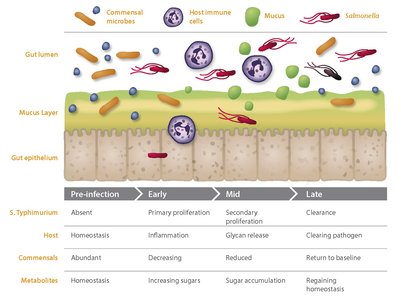The battle between good and bad bacteria in the gut
A new study that examined food poisoning infection ‘as it happens’ in mice revealed harmful bacteria, such as a common type of Salmonella, takes over beneficial bacteria within the gut amid previously unseen changes to the gut environment. The results provide new insights into the course of infection and could lead to better prevention or new treatments.
“We’re trying to tease apart a largely unknown area of biology,” said systems biologist Josh Adkins and team lead at the Department of Energy's Pacific Northwest National Laboratory. “Infection changes the populations of bacteria in the gut with resulting inflammation. We want to understand the interplay between these events.”
The study shows that Salmonella typhimurium might use the sugar fucose either as a sign that it has found a good place to reproduce or use fucose to sustain itself during infection, or both. This was the first time researchers saw fucose as an important player during Salmonella infection.
“We were taken completely by surprise with the fucose results,” said Adkins. They also saw other sugars that normally are eaten by resident bacteria going untouched. “By knowing what the bacteria eat, we can try to promote the good bacteria and throw off the battle.”
The mice
Food poisoning caused by Salmonella bacteria hits more than 40,000 people in the US every year. One of the common types that infect people, Salmonella Typhimurium, doesn’t usually make mice sick, so Adkins and colleagues used mice uniquely sensitive to Salmonella infection. After infecting mice with the disease-causing bacteria orally, the researchers could follow the course of the illness by analysing what came out of the other end of the mice.
“In most studies, researchers clear out the resident bacteria with antibiotics before introducing infectious bacteria,” said microbiologist Brooke Deatherage Kaiser. “In this study, we could watch Salmonella knock out the commensal organisms and then watch them come back. Following the interactions through time is not something we've been able to do before.”
The story they put together shows how Salmonella usurps microbes that normally populate the gut. Known as commensal bacteria, resident bugs perform important functions such as breaking down carbohydrates and sugars that people and mice can't. Using advanced instruments and techniques, the researchers identified which populations of bacteria dominated as infection progressed and mice recovered, as well as changes in the gastrointestinal tract, such as the presence of inflammation and available nutrients.
The sugars

While many events the team witnessed were expected, such as infection causing inflammation in the gut, some were not. One unexpected change was in the kinds of sugars available for bacteria to eat. A handful of sugars that good bacteria normally chow down on lay around the gut untouched.
This stockpile of unusual sugars likely occurred because the good bacteria had, by that point, been overtaken by Salmonella and another bacterial variety, Enterococci. Enteroccoci are normally found in the gut, but can take advantage of opportunities to overgrow their welcome.
Unexpectedly, several lines of evidence suggested that Salmonella might use the sugar fucose as a food source. This study showed that the bacteria produced proteins that specifically help it digest fucose, which was the first time these researchers observed fucose proteins during Salmonella infection.
Although additional research will be needed to flesh out the role of fucose in the infectious cycle of Salmonella typhimurium, this observation may help to control or prevent gastrointestinal infection in the future by a better understanding of nutrient sources and signals in the gut.
Overall, the study allowed the PNNL researchers to follow the rise and fall of the infecting bacteria, the fall and rise during recovery of the commensal bacteria, and changes to the gut as the mice fended off the infection. Future research will focus on what happens in other areas of the intestine to get a handle on the difference between the type of illness this study represented, acute gastrointestinal disease, and more systemic infection.
This work has been published on PLOS ONE.
Mimicking meat: texture science for plant-based meats
Stanford engineers are developing an approach to food texture testing that could pave the way for...
What's new on the shelf in the lead-up to Christmas
Chocolate baubles, fruity snacks, Milkybar milk and instant coffee with a cool twist are some of...
A vision of a food trend
Research at the University of Sydney tested the reactions of more than 600 people making food...














